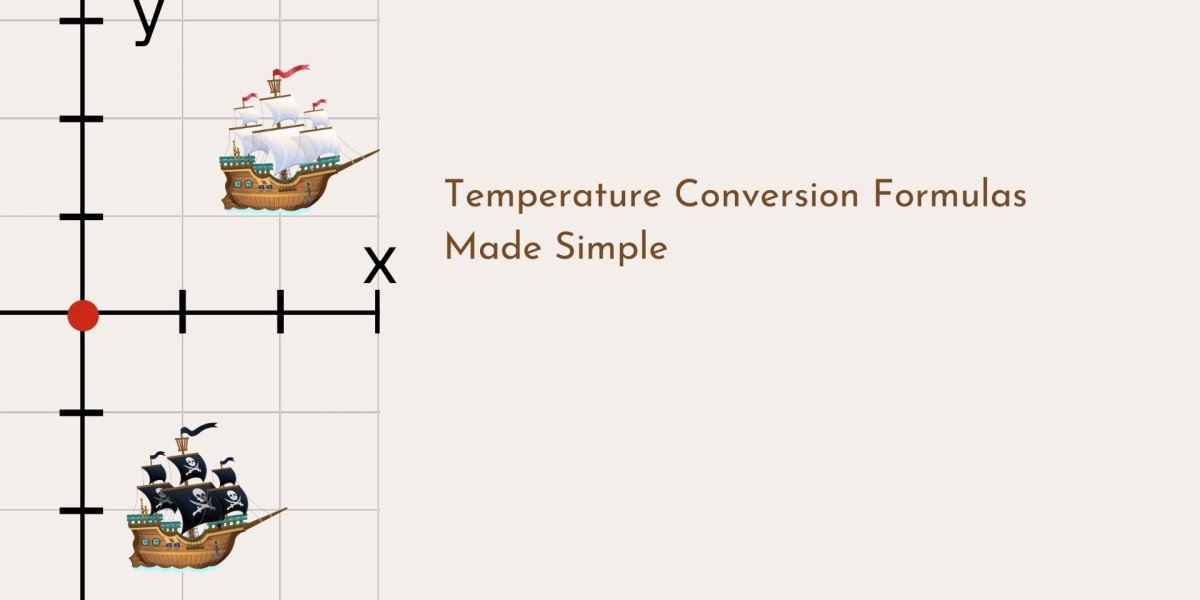Understanding temperature conversion is useful in more places than you might expect. Weather reports, recipes, science homework, medical readings, and technical manuals often use different scales. When you know the formulas and how to apply them, you can move between Celsius, Fahrenheit, and Kelvin with confidence.
Below is a step-by-step guide that walks through the ideas, formulas, and real examples in a clear, simple way.
What Is Temperature Conversion?
Temperature conversion means changing a value from one scale to another, for example, from Celsius (°C) to Fahrenheit (°F), or from Celsius to Kelvin (K). The goal is to keep the physical temperature the same while changing how it is measured.
Why Different Temperature Scales Exist
Different scales were created at different times, for different needs:
- Celsius was designed around the behavior of water.
- Fahrenheit came earlier and was meant to give whole numbers for common weather and household temperatures.
- Kelvin was created for scientific work and starts at absolute zero, the lowest possible temperature.
Because science, industry, and daily life all grew in different ways around the world, no single scale became universal. That is why temperatures still need to be converted.
Where Temperature Conversion Matters in Daily Life
You may need to convert temperatures when you:
- Read recipes or oven settings from another country
- Follow international weather forecasts
- Interpret body temperature in health contexts
- Work with lab instructions, engineering manuals, or scientific papers
- Set up equipment that uses a different default scale
Knowing the formulas saves time and reduces mistakes.
Main Temperature Scales Explained
Celsius (°C) – The Metric Standard
Celsius is used in most countries and in almost all scientific fields. It is based on water:
- 0 °C is the freezing point of water
- 100 °C is the boiling point of water (at standard pressure)
This simple range makes Celsius easy to understand and remember.
Fahrenheit (°F) – Common in the United States
Fahrenheit is still the standard in the United States for:
- Weather reports
- Household thermostats
- Cooking temperatures
On this scale:
- 32 °F is the freezing point of water
- 212 °F is the boiling point of water
Because the degree size is smaller, Fahrenheit gives more “fine-grained” numbers for day-to-day weather (for example, 70 °F vs 71 °F).
Kelvin (K) – Used in Science and Engineering
Kelvin is used for science, engineering, and high-precision work. It starts at absolute zero, the coldest possible temperature, where particle motion is minimal:
- 0 K is absolute zero
- 273.15 K is the same as 0 °C
- 373.15 K is the same as 100 °C
Kelvin does not use the degree symbol; you write K.
Core Temperature Conversion Formulas
These are the key formulas you will use again and again.
Celsius to Fahrenheit Formula
To convert Celsius to Fahrenheit:
°F=(°C×95)+32°F = (°C \times \frac{9}{5}) + 32°F=(°C×59)+32Example:
Convert 25 °C to °F.
- Multiply by 9/5: 25 × 9/5 = 45
- Add 32: 45 + 32 = 77
So, 25 °C = 77 °F.
Fahrenheit to Celsius Formula
To convert Fahrenheit to Celsius:
°C=(°F−32)×59°C = (°F - 32) \times \frac{5}{9}°C=(°F−32)×95Example:
Convert 98.6 °F to °C.
- Subtract 32: 98.6 − 32 = 66.6
- Multiply by 5/9: 66.6 × 5/9 ≈ 37
So, 98.6 °F ≈ 37 °C (normal body temperature).
Celsius to Kelvin Formula
To convert Celsius to Kelvin:
K=°C+273.15K = °C + 273.15K=°C+273.15Example:
20 °C + 273.15 = 293.15 K
Kelvin to Celsius Formula
To convert Kelvin to Celsius:
°C=K−273.15°C = K - 273.15°C=K−273.15Example:
310 K − 273.15 = 36.85 °C
Fahrenheit to Kelvin Formula
You can move from Fahrenheit to Kelvin in two steps (F → C → K), or use a direct formula.
Using steps:
- Convert °F to °C:
- °C=(°F−32)×59°C = (°F - 32) \times \frac{5}{9}°C=(°F−32)×95
- Convert °C to K:
- K=°C+273.15K = °C + 273.15K=°C+273.15
Direct formula:
K=(°F−32)×59+273.15K = (°F - 32) \times \frac{5}{9} + 273.15K=(°F−32)×95+273.15Kelvin to Fahrenheit Formula
Again, you can use two steps (K → C → F) or the direct formula.
Using steps:
- Convert K to °C:
- °C=K−273.15°C = K - 273.15°C=K−273.15
- Convert °C to °F:
- °F=(°C×95)+32°F = (°C \times \frac{9}{5}) + 32°F=(°C×59)+32
Direct formula:
°F=(K−273.15)×95+32°F = (K - 273.15) \times \frac{9}{5} + 32°F=(K−273.15)×59+32Temperature Conversion Chart (Quick Reference)
Charts are useful when you want a quick view instead of calculating each time.
Side-by-Side °C to °F Table
Here is a simple reference for common temperatures:
Celsius (°C)Fahrenheit (°F)
-10 14
0 32
10 50
20 68
25 77
30 86
37 98.6
40 104
You can expand this table for your own needs, for example, for cooking or climate data.
Celsius to Kelvin and Kelvin to Celsius Table
Celsius (°C)Kelvin (K)
-273.15 0
0 273.15
25 298.15
37 310.15
100 373.15
Even a short table like this can speed up your work in scientific or technical contexts.
Step-by-Step Conversion Examples
Examples help lock the formulas in your memory.
Converting Weather Temperatures
Example 1: A cool day in Celsius to Fahrenheit
Imagine a forecast of 15 °C. What is this in °F?
- Multiply by 9/5: 15 × 9/5 = 27
- Add 32: 27 + 32 = 59
So, 15 °C = 59 °F. That is a mild day.
Example 2: A hot day in Fahrenheit to Celsius
Now imagine a forecast of 95 °F. What is this in °C?
- Subtract 32: 95 − 32 = 63
- Multiply by 5/9: 63 × 5/9 = 35
So, 95 °F = 35 °C, which is quite hot.
Converting Oven and Cooking Temperatures
Many recipes are written in °C, while some ovens show °F.
Example: A recipe says “Bake at 180 °C”.
Convert to Fahrenheit:
- 180 × 9/5 = 324
- 324 + 32 = 356
So, set the oven to about 350–360 °F. Most cooks round to the nearest common setting, so 350°F is usually fine.
Converting Temperatures for Science Experiments
Scientific work often uses Kelvin, especially in physics and chemistry.
Example: An experiment is run at 25 °C. What is the temperature in K?
- 25 + 273.15 = 298.15 K
Example: A gas law problem mentions 400 K. What is this in °C?
- 400 − 273.15 = 126.85 °C
Converting correctly is important because many formulas only work when the temperature is expressed in Kelvin.
How to Convert Temperatures Mentally
You will not always have a calculator nearby. Simple mental tricks help you get an approximate value fast.
Fast Approximation Tricks for °C and °F
A quick method to estimate is:
- Celsius to Fahrenheit (rough):
- Double the °C value and add 30.
- Example:
- 20 °C → 20 × 2 = 40, plus 30 ≈ 70 °F
- The exact answer is 68 °F, so this is close.
- Fahrenheit to Celsius (rough):
- Subtract 30, then halve the result.
- Example:
- 86 °F → 86 − 30 = 56; half is 28 °C
- The exact answer is 30 °C, so again, this is close enough for a quick estimate.
These shortcuts are not perfect, but they help you understand how warm or cold something is at a glance.
Simple Rules You Can Remember
A few anchor points make mental conversion easier:
- Water freezes at 0 °C and 32 °F
- Water boils at 100 °C and 212 °F
- Room temperature is about 20–22 °C or 68–72 °F
- Normal body temperature is about 37 °C or 98–99 °F
If you remember these, you can estimate nearby values more easily.
Digital Temperature Conversion Tools
Even with strong basics, digital tools save time when you work with many values or need high accuracy.
Online Converters and Mobile Apps
Many websites and apps let you enter a temperature in one scale and get instant results in another. These tools are especially useful if you:
- Compare long lists of temperatures
- Switch between multiple scales in one project
- Work with sensitive data in medicine, chemistry, or engineering
In areas like healthcare and laboratory work, you often need more than temperature conversion. For example, dosages can depend on both mass and volume. In such cases, a dedicated mg to ml converter helps you move from milligrams to milliliters accurately, while temperature calculators keep your thermal conditions on target. Using the right specialized tool for each type of conversion keeps your data consistent and your decisions safe.
Using Spreadsheets for Bulk Conversions
If you need to convert a large number of temperatures, a spreadsheet is very effective.
For example, in a spreadsheet:
- Put °C values in column A
- In column B, use a formula for °F:
- =A2*9/5+32
- Fill the formula down to apply it to all rows
You can do the same for °C ↔ K or °F ↔ K. This approach is ideal for climate data, sensor logs, or research measurements.
Real-World Uses of Temperature Conversion
Temperature conversion is not only for textbooks. It solves real problems in many areas.
Travel and Reading International Weather Reports
When you travel or read global news, you may see temperatures reported in a scale you do not use every day. If you know that:
- 0 °C = 32 °F (freezing)
- 30 °C ≈ 86 °F (hot)
You can understand any weather report more easily. It becomes simpler to plan clothing, activities, and even air-conditioning settings.
Health and Understanding Body Temperature
Thermometers might show readings in °C or °F, depending on the region or device. Correctly interpreting body temperature matters for health decisions:
- 37 °C ≈ 98.6 °F (normal)
- 38 °C ≈ 100.4 °F (fever)
If someone sends you a reading in a different scale, knowing how to convert it gives quick clarity.
Industry, Engineering, and Laboratory Work
In professional settings, mistakes in temperature can be costly:
- Manufacturing processes often have tight temperature ranges
- Chemical reactions may only occur safely within a narrow band
- Electronic devices and materials can fail if they overheat or get too cold
Engineers and scientists may record data in Kelvin for equations, then convert to Celsius for reporting. Accurate conversion protects quality, safety, and reliability.
Key Temperature Conversion Formulas at a Glance
To close, here is a compact summary of the most important formulas. These cover almost every everyday situation you will face.
Formula Summary for Quick Review
- Celsius to Fahrenheit
- °F=(°C×95)+32°F = (°C \times \frac{9}{5}) + 32°F=(°C×59)+32
- Fahrenheit to Celsius
- °C=(°F−32)×59°C = (°F - 32) \times \frac{5}{9}°C=(°F−32)×95
- Celsius to Kelvin
- K=°C+273.15K = °C + 273.15K=°C+273.15
- Kelvin to Celsius
- °C=K−273.15°C = K - 273.15°C=K−273.15
- Fahrenheit to Kelvin
- K=(°F−32)×59+273.15K = (°F - 32) \times \frac{5}{9} + 273.15K=(°F−32)×95+273.15
- Kelvin to Fahrenheit
- °F=(K−273.15)×95+32°F = (K - 273.15) \times \frac{9}{5} + 32°F=(K−273.15)×59+32
Downloadable or Printable Cheat Sheet Idea
Once you are comfortable with these formulas, you can place a short list and a small °C ↔ °F ↔ K table near your desk, kitchen, or lab bench. That way, accurate temperature conversion becomes part of your routine, and you work faster with fewer errors.







